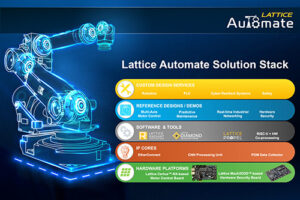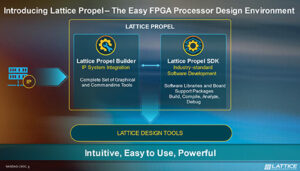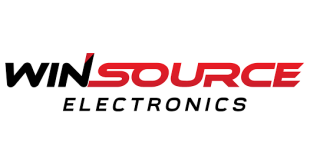 By Eric van der Heijden, Vice President of Sales, EMEA, at Lattice Semiconductor
By Eric van der Heijden, Vice President of Sales, EMEA, at Lattice Semiconductor
Globally, smart factories are now leveraging advanced automation applications such as augmented reality, autonomous mobile robots, cobots, and industrial sensors. Even beyond the traditional factory floor, automation is accelerating in areas like warehouse automation and logistics using similar applications. These new working practices are practical today because of hardware improvements that provide real-time networking, high-performance processing, high reliability, low power consumption, and interface flexibility.
24/7/365 operation in industrial and logistics environments increases stress on devices, especially in systems with active drives and motors, and a single motor failure can halt operations or production. Newer computing solutions for automation, such as integrated edge AI engines, can identify these irregularities and predict failures well in advance so that operators can be alerted, parts can be pre-ordered, maintenance scheduled, and overall operational efficiency increased.
Increasingly sophisticated automation solutions require the support of leading silicon technology providers throughout the hardware and software stack. A flexible hardware architecture, at the lowest level, is critical for maintaining the pace of innovation for industrial and logistics automation solutions. Today, software development comprises the bulk of development cost and labour in industrial projects, placing great value on supporting libraries, toolsets, and ecosystem support from automation technology providers.
FPGAs suit flexible demands of automation
FPGAs with integrated processors combine the flexibility, performance, and programmability to support the rapid adoption and deployment of new technologies to meet the evolving needs of industrial automation. FPGAs, in particular, feature unique flexibility to support a range of dynamic automation computing profiles and requirements. Today’s FPGAs feature very low power consumption and efficient energy usage, enabling them to be designed in smaller form factors with simplified cooling, which is critical at the network edge. FPGAs are also completely customizable, with a range of benefits over software-based solutions, such as lower latency. In addition, FPGAs support high-performance control loops, PWM, and more connected control motors per unit than comparable high-end MCUs. Lattice Semiconductor offers FPGAs with extremely low soft error rates for improved reliability, which is optimal for applications requiring high availability and functional safety.
Silicon can protect against cyber attacks
Hardware security is paramount for protection against increasingly common cyber attacks. MCU and/or software-based solutions are unable to match the real-time protection that alternatives like FPGAs provide with instant detection, high-performance coverage of multiple subsystems, and the ability to roll back to a known good state to recover from attacks, which is critical. FPGAs can be highly secure and resilient with monitors at the lowest level (beneath the operating system) — protecting firmware before/during/after boot, securing/validating code itself, and providing a root- of-trust.
 Optimized libraries for automation
Optimized libraries for automation
A flexible hardware foundation requires equally strong software support from semiconductor providers and their partnership ecosystem, particularly for automation solutions. Software development already comprises the vast majority of development costs in industrial automation and control projects, so high-quality support is crucial to project success. Lattice Semiconductor, for example, provides a base platform of lightweight protocols for real-time sense and control using Ethernet for networking (e.g., enabling multi-axis motor control over Industrial Ethernet while daisy-chained to multiple monitors). In addition, high performance FPGAs are becoming more software-friendly, offering software programming tools and graphical design environments like the Lattice Propel™ design environment (Figure 1).
Automation often incorporates several functional domains with special software requirements, including edge AI, embedded vision, and security stacked on top of lower-level software like operating systems and firmware. Access to more sophisticated software libraries and IP from semiconductor providers in these domains is particularly important for optimizing performance and power efficiency with on-chip accelerators and hardware resources.
Software and hardware programmability
While programmable hardware supporting low power, high performance computing with low latency is highly beneficial, some workloads are better controlled or implemented in software. For example, software programmability is optimal for predictive maintenance applications, and also enables development with more prevalent developer skillsets (e.g., programming in C). The combination of FPGAs with traditional processor types in heterogeneous system-on-chips, modules/boards, and integrated computing systems enables hardware-software co-processing and advanced system flexibility.
Automate – the industrial automation stack from Lattice
Automation solutions today feature many dynamic components and subsystems that must be developed in harmony to be competitive in the market. Support for motor control, edge AI, sensor fusion, functional safety, computer vision, and security all must tie neatly together in an end-to-end automation solution to accelerate adoption and commercial rollouts.
To help customers navigate these challenges, leading silicon technology providers are offering more vertical-/application-specific support to accelerate development of new workloads, such as predictive maintenance proof of concepts, experimentation with new co-processing architectures, and prototyping to new specifications/integrations. The Lattice Automate™ industrial automation solution stack, shown in Figure 2 is an example the full solution approach now available.
Read the full whitepaper here.
 CIE Components in Electronics
CIE Components in Electronics



